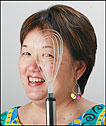
|
By Request
Betty Shimabukuro
|
Hawaii visitor wants recipe for tripe poke
One of the best souvenirs of a vacation is the discovery of a new food. So it was for Glenn Takano, a recent visitor from Maryland who picked up some Tripe Poke "from a store in Waianae or Nanakuli somewhere."
"I am not a fan of tripe, but being an adventurous food consumer, I tasted it," Takano wrote once he got home. "Much to my surprise, it was absolutely wonderful!"
It wasn't hard to track the poke to Tamura Superette in Waianae, where part-owner Clifford Tamura makes a batch nearly every day for the deli. But Tamura wants to keep his recipe secret. He gave me a rough idea of the ingredients, but I'm not allowed to tell anyone else. I can safely pass on only two things: 1) He got the idea when eating a Korean tripe dish; and 2) one of the ingredients is salt.
OK, but Takano wants to make this at home, so it was on to a more effusive source: chef Sam Choy. "That one is my favorite," Choy said when posed with the question. "It's very, very good. I don't know why people don't eat it more."
He doesn't serve it in his restaurants, but makes it for potlucks and tailgating.
Tripe Poke doesn't fit the usual image of poke - raw seafood, usually ahi, mixed with soy sauce, ogo and onions. The beef tripe is cooked, which takes some long simmering, then chilled down and mixed with Korean-style flavorings.
It qualifies as poke in the loosest sense - the word is Hawaiian for slicing or cutting, and the tripe is cut into pieces, so there you go.
Choy says he uses book tripe, also called bible or leaf tripe, which cooks faster than honeycomb or blanket tripes. He says the other types have more flavor, but "you boil that forever."
Along with the tripe, you'll need Korean kochujang sauce, a chili pepper paste that includes fermented soybeans. It's sold in the Asian section of most supermarkets. Choy says for a different flavor you can substitute kim chee base, a mixture of chilies and garlic. Korean markets offer many types of the base. Regular supermarkets sometimes carry Park's brand, sold refrigerated near the prepared kim chee.
Sam Choy’s Tripe Poke
1 pound beef book tripe
1 cup thinly sliced green onions
1 cup diced onion
1-1/2 tablespoons roasted sesame seeds
1 tablespoon sesame oil
1 to 2 Hawaiian chili peppers, minced
1-1/2 tablespoons Korean kochujang sauce
1 tablespoon (or less) sugar
1 tablespoon soy sauce
1/2 teaspoon vinegar or lime juice
Simmer tripe in water until soft enough to pierce with your finger. Rinse in cold water. Slice and chill well, overnight if possible.
Combine with onions, sesame seeds, sesame oil and chilies.
In separate bowl, combine kochujang sauce, sugar, soy sauce and vinegar. Stir this sauce into tripe mixture. Serves 8.
Approximate nutritional analysis, per serving: 100 calories, 5 g fat, 1 g saturated fat, 70 mg cholesterol, 250 mg sodium, 6 g carbohydrate, 1 g fiber, 4 g sugar, 8 g protein.
Nutritional analyses by Joannie Dobbs, Ph.D., C.N.S.
Send queries along with name and phone number to: "By Request," Honolulu Star-Bulletin, 500 Ala Moana, No. 7-210, Honolulu 96813. Or send e-mail to
bshimabukuro@starbulletin.com

